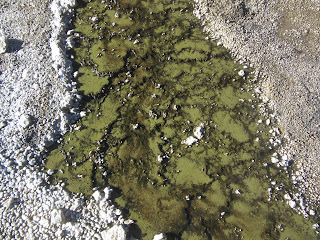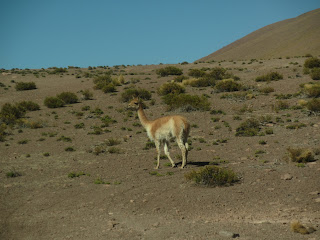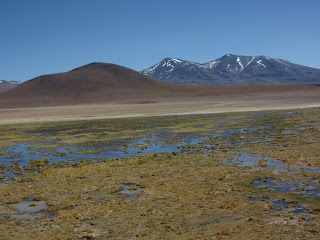Our third tour with Cosmo Andino Expeditions was a visit to the Geysers del Tatio beginning at the ungodly hour of 4:30 in the morning! The geysers, one of Chile's main tourist attractions, is the world's highest geothermal field. Located in the Cordillera of the Andes 55 miles northeast from San Pedro de Atacama, El Tatio is the largest group of geysers in the southern hemisphere and the third largest in the world, after Yellowstone and Dolina Giezerow in Russia.
After a two hour bus trip on a relentlessly bumpy road and a climb in elevation from 8,200'-14,763’ in under 55 miles, we reached the high plateau about daybreak. The tour agency had advised us not to eat breakfast and to chew coca leaves before leaving San Pedro de Atacama to cope with the 6,500' increase in elevation in such a short time. Neither Steven nor I wanted to go near coca leaves again after our experience in Peru earlier on this trip!
The mountain in the background was known as Mont Blanc, after the Swiss mountain of the same name. Because we were already at an elevation of over 14,000 feet, Chile's Mont Blanc didn't look as commanding as the Swiss version I saw back in the mid-70s when I was an au pair and lived in Geneva for a year. However, Chile's was about 150 feet higher!
Our guide explained that a 20 year-old Frenchman had fallen in this fumarole after he had gotten too close to it; he died four days later. It was only after that the barrier of red rocks was put up so people would no longer face the same danger.
The thermal pools were temporarily closed because previous tourists had reported skin issues after swimming in them. We didn't mind we couldn't swim as the temperatures were so frigid even the ink in my pen didn't flow!
This fumarole was called The Killer because it had claimed the lives of three or four people who had been too close! It was impossible to see the actual bubbling water through the steam.
After walking around many of the vents, our guide beckoned us to return to the van where the driver had a hot breakfast waiting for us. The yummy scrambled eggs on warm biscuits and tea or hot chocolate were so welcome as it was still mighty cold!
Not far away was an almost 10' deep pool that contained algae that looked like a mountain range!
The many reddish hues we'd seen just yesterday on our tour of the lunar landscapes in the Valley of the Moon and Valley of Death had been spectacular. However, these intense greens and rusts gave those valleys a run for the money on the color wheel! I don't think I have ever seen those shades in nature before.
We trooped back to the van so we could observe the north part of the geyser field. Luckily, the increasing temperatures also warmed up the ink in my pen at last!
It had been a twenty minute cycle from beginning to end. I don't think any of us on the tour minded then having had to get up so early so we could marvel at one of Mother Nature's incredible feats!
Yet more amazing colors were visible on the earth's surface.
This 'dead' geyser was active until three years ago. The guide stressed it could become active again. The white color was from salt and carbonate present near the geyser.
In one of the Machuca lakes, we spotted some Andean flamingos.
Also present were a couple of Gaviota Andina birds who live in small flocks in lakes, bogs and lowlands. The rare birds build their floating nests over rocks and sometimes use abandoned nests.
The Cardon Cactus grew up to 30' high and was about 2.5' in diameter and had white petal flowers. Its wood is used for wood beams, doors, window frames and furniture making.
We had to shed all but the last layer of clothes because it was so warm down by the Pilama River where we hiked to see more of the largest cacti in the world.
As the cacti only grow one centimeter a year, these were over 500 years old!
These were a few of our tour companions who made the day so much more enjoyable.
Once back in town by 1, we bought tickets for the shuttle to the airport located two hours away for two days' hence before heading back to our guesthouse.
All the tours leave San Pedro de Atacama well before dawn to reach El Tatio while the geysers are most active, i.e. in the early hours of the day. We arrived around 6 am and got to see the sunrise without seeing the actual sun, but the way the light started to fill the place was magical! The jets of stream were already shooting into the air as the sun slowly poked its head over the adjacent cordillera.
The geothermal field was managed by the Tatio Mallku Society, formed by Atacama's Tocone and Caspana communities in 2006. Through this organization, the members administer the cultural and natural heritage by taking care of the magical place and all tourist activity.The mountain in the background was known as Mont Blanc, after the Swiss mountain of the same name. Because we were already at an elevation of over 14,000 feet, Chile's Mont Blanc didn't look as commanding as the Swiss version I saw back in the mid-70s when I was an au pair and lived in Geneva for a year. However, Chile's was about 150 feet higher!
The guide said we would only have about thirty minutes to walk around this area before seeing more geysers elsewhere. That seemed way too little for such a big area. Luckily, his concept of thirty minutes stretched to well more than an hour so we were all relieved not to have to rush in this fantastic place we'd come so far to see.
As the temperature was only about 28 degrees, everyone was shivering as we stood around and listened to our guide. He explained the field's different phenomena included bubbling pools, bubbling mud pools, bubbling springs, hot springs, boiling springs, mud volcanoes, evaporating soil and hot pools where temperatures were 'only' 104 degrees!
Because of the active state of some of the phenomena where temperatures reach about 190 degrees Fahrenheit, we were strongly cautioned to follow the guide's every instruction during the tour.
Standing among the steaming fumaroles as the sun rose over the edge of a volcanic crater was a truly magical experience.Our guide explained that a 20 year-old Frenchman had fallen in this fumarole after he had gotten too close to it; he died four days later. It was only after that the barrier of red rocks was put up so people would no longer face the same danger.
The sun shining on the mountain was a gorgeous sight. I just wished the sun would warm the area where we were soon!
The thermal pools were temporarily closed because previous tourists had reported skin issues after swimming in them. We didn't mind we couldn't swim as the temperatures were so frigid even the ink in my pen didn't flow!
When the steam and hot water come out from below the earth to the surface, they appear most commonly as springs, geysers and fumaroles. The El Tatio geothermal field, located at more than 14,3107 feet above sea level, had more than 500 'thermal surface manifestations.'
A plaque described the hot subterranean water builds up pressure which is then released up through cracks in the earth's crust. The boiling water reaches temperatures of about 185 degrees F. The fumaroles or steam vents occur due to the contrast with the cold ambient temperature and can reach heights up to 33'.
This fumarole was called The Killer because it had claimed the lives of three or four people who had been too close! It was impossible to see the actual bubbling water through the steam.
After walking around many of the vents, our guide beckoned us to return to the van where the driver had a hot breakfast waiting for us. The yummy scrambled eggs on warm biscuits and tea or hot chocolate were so welcome as it was still mighty cold!
Not far away was an almost 10' deep pool that contained algae that looked like a mountain range!
Our guide warned that, if it were touched, it would be destroyed.
As the sun heated the cold, barren land, the force of the geysers slowly diminished which allowed us to explore the mud pots and craters formed by the escaping steam.
We walked carefully over the stream that had the most vibrant shades of green from algae and minerals.
The black blobs were two cm long snakes!
Our guide stated these infinitesimal spots were the first life forms on the planet and were bacteria that came from meteors! The guide joked we had met our ancestors!
We trooped back to the van so we could observe the north part of the geyser field. Luckily, the increasing temperatures also warmed up the ink in my pen at last!
You've watched a pot boil, right?! Well, imagine waiting and waiting until the water in the earth warmed up enough for a geyser to actually occur! I bet everyone on our tour waited a good 15 minutes before finally giving up and moving onto another one as we just saw bits of steam escaping from the crack in the earth. I kept thinking of the witches in Macbeth, 'Bubble, bubble, toil and trouble' but there was no 'trouble' here!
Up ahead was the mother of all geysers, the one that spurted stem up to almost 35' into the air.
As we neared it, we saw lots and lots of steam but it was impossible for me to catch the sprays of water on film because of the steam.
One of my more unusual photographs:
I loved looking at the different formations of steam.
When the geyser disappeared several minutes later, it looked innocuous enough. However, a Belgian woman died thinking it was safe to draw near and her husband had serious burns to his hands trying to pull her out. The geyser has since been called The Belgian Woman Geyser - what a sad way to be immortalized.
We watched and, more importantly, listened, as another geyser was forming under the earth. What an experience hearing the increased gurgling, mini-thunder sounds, then seeing the water begin to bubble in the small vent and, then later, the steam rise to huge heights with water spraying at ever increasing heights. What incredible sounds and sights we witnessed.
It had been a twenty minute cycle from beginning to end. I don't think any of us on the tour minded then having had to get up so early so we could marvel at one of Mother Nature's incredible feats!
Yet more amazing colors were visible on the earth's surface.
The guide joked this was a cappuccino machine! In reality, the government wanted to capitalize on the area's thermolectric power but the plan faced considerable opposition from the indigenous people who owned the land. As a result, the government cancelled their plans.
There were 70 geysers and 180 fumaroles or steam vents in El Tatio. The yellow color came from sulphur, the red from iron and magnesium formed the distinctive green color, according to our guide.
Inside craters like this were cones which only grow at a rate of three feet every four thousand years!
No noise emanates from a fumarole, only from a 'spola' (sp?)This 'dead' geyser was active until three years ago. The guide stressed it could become active again. The white color was from salt and carbonate present near the geyser.
Our last sight on the geothermal field was what our guide called The Grandfather of the domes at El Tatio!
As we drove toward the Putana Wetlands, we saw a few vicuñas who only survive between 11,600 and 18,000 plus feet altitude. A companion camelid, guanacos, lived at lower altitudes.
The guide indicated a nearby old sulphur camp had been so important to the copper industry as sulphur was once used to separate copper. Now chemical products are used to separate the copper.
The cattle breeding pen was used by indigenous people.
The wetlands were a very fragile environment where Black Coots and Andean Geese lived.
Andean geese are so faithful that if one half of the couple dies, the other one does, too.
As we drove toward Machuca next, we were lucky enough to see more vicuñas by a babbling brook. The guide indicated it is illegal to hunt the animals. Nor can they be domesticated as they get sick and die. Their fur is so valuable that it would cost $30,000 for just one vicuña sweater!
I am pretty sure the green-colored, compact native plant, typical of the Chilean high mountain's arid environments, was llareta. Found at altitudes between 10,500' and over 14,000', it only grows at the slow rate of .19 of an inch per year. It had previously been intensively exploited as fuel; due to preservation programs, it is now coming back in greater numbers.
The Machuca River reaches San Pedro de Atacama and is used for irrigation.
The small village of Machuca - an ancient indigenous name - wasn't as old as its church as people lived along the river until just 40 years ago.
According to our itinerary, we were supposed to have stopped in the village but the guide said it was so touristy and wasn't worth it. I could only think that we, too, were tourists so, why not?! We had to content ourselves with a few photos from the side of the road and watch as fellow 'tourists' walked to the church.In one of the Machuca lakes, we spotted some Andean flamingos.
Also present were a couple of Gaviota Andina birds who live in small flocks in lakes, bogs and lowlands. The rare birds build their floating nests over rocks and sometimes use abandoned nests.
A view from the eighth highest summit in the Andes of the Atacama Salt Flat:
This was the only salt flat in the world that wasn't white AND also wasn't flat. There was salt on the surface but it wasn't dissolved as the area receives less than two inches of rain per year.
The wild donkeys used to transport items between Chile and Argentina when there were few roads. They were now wild and had a 'better lifestyle' as they were free, according to the guide.
Steven climbed up an impressive distance so I could take these shots of him among the cacti.
These were a few of our tour companions who made the day so much more enjoyable.
Once back in town by 1, we bought tickets for the shuttle to the airport located two hours away for two days' hence before heading back to our guesthouse.
There, Steven relaxed on the patio while I wrote another post about our time in the Galapagos from mid-October. Wow - that seems so long ago now!
Next post: The most spectacular flamingos imaginable at Los Flamencos National Reserve.
Posted on April 4th, 2018, from Littleton, Colorado.



















































































































Lovely flamingos.
ReplyDeleteJust wait until the next post as the flamingos we saw in Los Flamencos National Reserve were the most stunning of the hundreds we saw all trip!
ReplyDelete